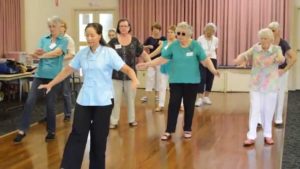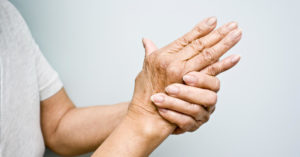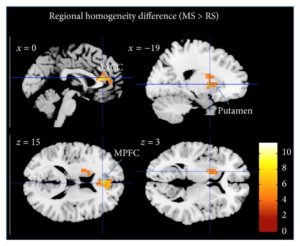
By John M. de Castro, Ph.D.
“Tai chi is often described as “meditation in motion,” but it might well be called “medication in motion.” There is growing evidence that this mind-body practice, which originated in China as a martial art, has value in treating or preventing many health problems. And you can get started even if you aren’t in top shape or the best of health.” – Harvard Women’s Health Watch
Arthritis is a chronic disease that most commonly affects the joints. Depending on the type of arthritis, symptoms may include pain, stiffness, swelling, redness, and decreased range of motion. It affects an estimated 52.5 million adults in the United States. It is associated with aging as arthritis occurs in only 7% of adults ages 18–44, while 30% adults ages 45–64 are affected, and 50% of adults ages 65 or older. Due to complications associated with rheumatoid arthritis (RA), the lifespan for people with RA may be shortened by 10 years. This is due to a higher incidence of cardiovascular disease in rheumatoid arthritis (RA) patients, with the risk more than double that of non-RA individuals.
Cardiovascular disease is the number one killer, claiming more lives than all forms of cancer combined. “Heart disease is the leading cause of death for both men and women. About 610,000 people die of heart disease in the United States every year–that’s 1 in every 4 deaths. Every year about 735,000 Americans have a heart attack” (Centers for Disease Control). Rheumatoid arthritis is associated with high levels of inflammation and inflammation damages blood vessels. It can lead to hardening of the arteries (arteriosclerosis) which in turn leads to cardiovascular disease. So, there is a need for treatments to reduce inflammation and hardening of the arteries in rheumatoid arthritis (RA) patients.
Contemplative practices have been shown to be helpful for heart health particularly those that are also exercises such as tai chi and yoga. Tai chi is an ancient contemplative practice involving slow motion smooth mindful movement. The reason that it has continued to be practiced by millions for centuries is that it has major mental and physical benefits including a reduction in the inflammatory response. Modern research is verifying these benefits. Mindful movement practice has been shown to improve balance, self-concept, and attention span, reduce falls, boost the immune system and helps to relieve symptoms of arthritis, asthma, Parkinson’s disease, insomnia, even improve cancer recovery, and improve recovery from heart failure. So, it makes sense to further explore the effectiveness of Tai Chi practice for hardening of the arteries in rheumatoid arthritis (RA) patients.
In today’s Research News article “The beneficial effects of Tai Chi exercise on endothelial function and arterial stiffness in elderly women with rheumatoid arthritis.” See:
or see summary below or view the full text of the study at:
https://www.ncbi.nlm.nih.gov/pmc/articles/PMC4718020/
Shin and colleagues recruited female rheumatoid arthritis patients (average 64 years old) and randomly assigned them to either receive 3 months of Tai Chi training or education about rheumatoid arthritis, its effects and methods of control. At the end of training they found that, in comparison to the education group, the Tai Chi group had a significant (32%) improvements in the ability of the blood vessels to dilatate in response to blood flows, (6%) reduction in arterial stiffness, and a significant decrease in total cholesterol. They found that the effectiveness of Tai Chi to improve the blood vessels was independent of its effects on cholesterol.
These results are impressive and important. Tai Chi exercise was effective in reducing the hardening of the arteries and blood cholesterol levels that normally are problematic with rheumatoid arthritis. This suggests that Tai Chi practice may reduce the cardiovascular disease which is a potentially fatal consequence of rheumatoid arthritis. Importantly, since rheumatoid arthritis impairs movement, Tai Chi is a very gentle practice, it is safe for a wide range of individuals, including the elderly and patients compromised by other illnesses including rheumatoid arthritis. So, tai chi is an excellent light exercise program that can improve hardening of the arteries and cholesterol levels and potentially reduce the risk of cardiovascular disease and death in rheumatoid arthritis patients.
So, improve circulation with Tai Chi.
CMCS – Center for Mindfulness and Contemplative Studies
“Qi gong and tai chi are relaxing ways to improve your flexibility and balance. Both are great ways to stay active and vital. The gentle, flowing movements are easy on the joints.” – Melinda Ratini
This and other Contemplative Studies posts are also available on Google+ https://plus.google.com/106784388191201299496/posts
Study Summary
Shin, J.-H., Lee, Y., Kim, S. G., Choi, B. Y., Lee, H.-S., & Bang, S.-Y. (2015). The beneficial effects of Tai Chi exercise on endothelial function and arterial stiffness in elderly women with rheumatoid arthritis. Arthritis Research & Therapy, 17, 380. http://doi.org/10.1186/s13075-015-0893-x
Abstract
Background: Rheumatoid arthritis (RA) has been known to be associated with increased risk of cardiovascular disease (CVD). The aim of this study was to investigate the effects of Tai Chi exercise on CVD risk in elderly women with RA.
Method: In total, 56 female patients with RA were assigned to either a Tai Chi exercise group (29 patients) receiving a 3-month exercise intervention once a week or a control group (27 patients) receiving general information about the benefits of exercise. All participants were assessed at baseline and at 3 months for RA disease activity (Disease Activity Score 28 and Routine Assessment of Patient Index Data 3), functional disability (Health Assessment Questionnaire), CVD risk factors (blood pressure, lipids profile, body composition, and smoking), and three atherosclerotic measurements: carotid intima-media thickness, flow-mediated dilatation (FMD), and brachial-ankle pulse wave velocity (baPWV).
Results: FMD, representative of endothelial function, significantly increased in the Tai Chi exercise group (initial 5.85 ± 2.05 versus 3 months 7.75 ± 2.53 %) compared with the control group (initial 6.31 ± 2.12 versus 3 months 5.78 ± 2.13 %) (P = 1.76 × 10−3). Moreover, baPWV, representative of arterial stiffness, significantly decreased in the Tai Chi exercise group (initial 1693.7 ± 348.3 versus 3 months 1600.1 ± 291.0 cm/s) compared with the control group (initial 1740.3 ± 185.3 versus 3 months 1792.8 ± 326.1 cm/s) (P = 1.57 × 10−2). In addition, total cholesterol decreased significantly in the Tai Chi exercise group compared with the control group (−7.8 ± 15.5 versus 2.9 ± 12.2 mg/dl, P = 2.72 × 10−2); other changes in RA-related characteristics were not significantly different between the two groups. Tai Chi exercise remained significantly associated with improved endothelial function (FMD; P = 4.32 × 10−3) and arterial stiffness (baPWV; P = 2.22 × 10−2) after adjustment for improvement in total cholesterol level.
Conclusion: Tai Chi exercise improved endothelial dysfunction and arterial stiffness in elderly women with RA, suggesting that it can be a useful behavioral strategy for CVD prevention in patients with RA.
https://www.ncbi.nlm.nih.gov/pmc/articles/PMC4718020/







